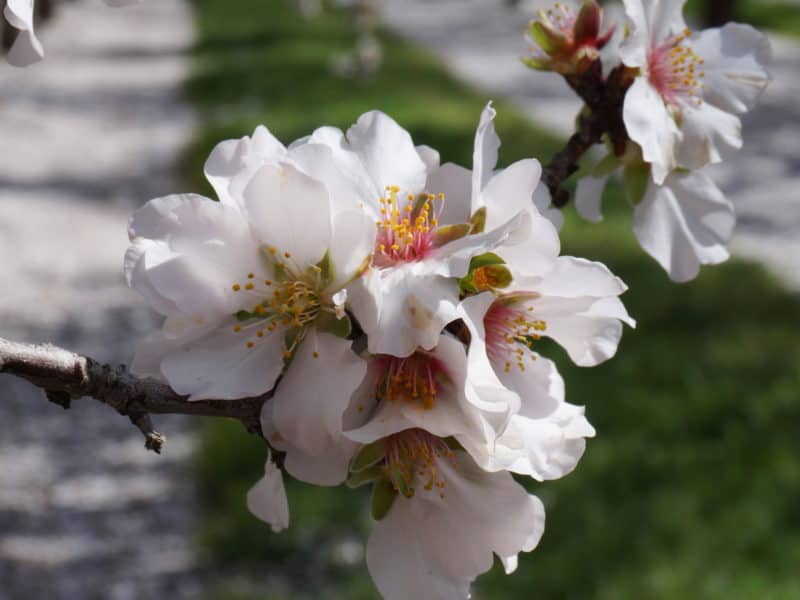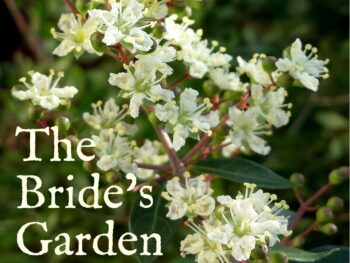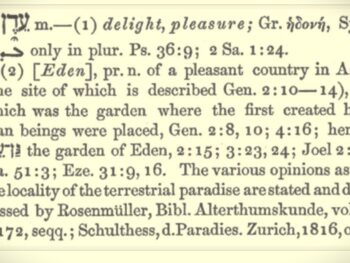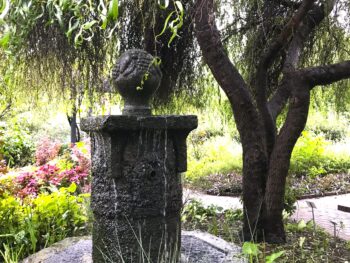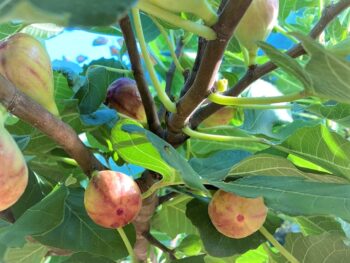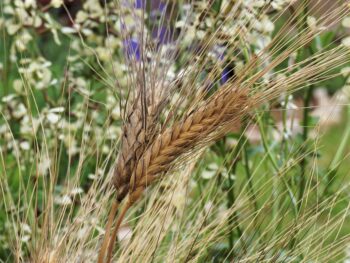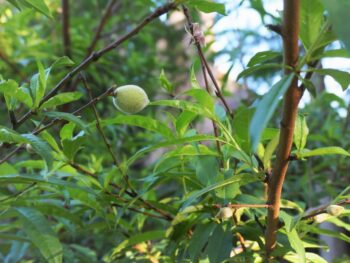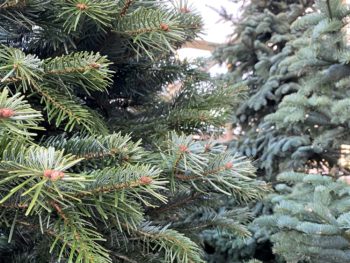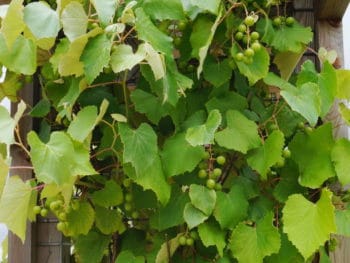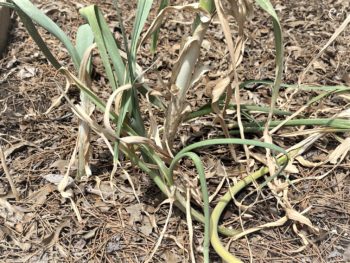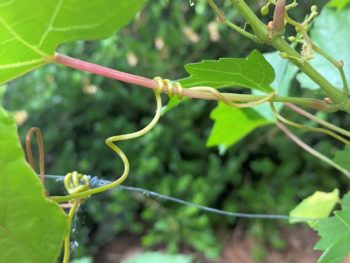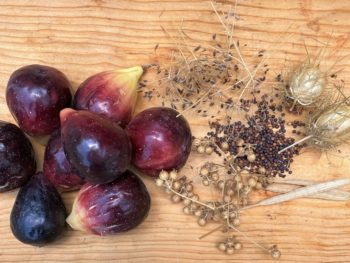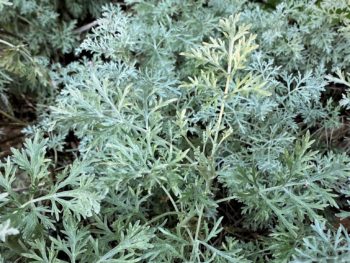
Almond Trees
The word of the Lord came to me: “What do you see, Jeremiah?”
“I see the branch of an almond tree,” I replied….
What do you watch for?? Your garden’s first flower in spring? The first fluffy, white snowflake to fall? The first lighting of a Christmas tree, or dawn’s first light? If imagining such breathtaking moments arrests you in awe, causing you to watch in wonder, then almond is your tree.
Almond trees were spring’s first flowering trees to blossom in the Holy Land. Picture the dull, brown-gray winter landscape suddenly dotted with blush-white tufts of petals and posies, alive with the buzz of bees, a sweet, rosy scent wafting across the land—captivating! They became a symbol for first sightings, and encouragement to see a first sign and watch for more to come.
Word Play
…The Lord said to me, “You have seen correctly, for I am watching to see that my word is fulfilled.”
Jeremiah 1:11-12 NIV

The Lampstand
Knowing this, look back with me from Jeremiah to Exodus, to the artist crafting the lampstand for the tabernacle. Gardener, gardener, what do you see?
He made the entire lampstand and its decorations of one piece—the base, center stem, lamp cups, buds, and petals. The lampstand had six branches going out from the center stem, three on each side. Each of the six branches had three lamp cups shaped like almond blossoms, complete with buds and petals.
Exodus 37:17-19 NLT
Almond blossoms! The adorable flowers, symbols of first sightings, decorated the golden lampstand that illuminated the holy place. Yet there is meaning beyond the practical provision of light for the space, and with almond flowers, we have our horticultural hint. What does God want his people to see, what insight is he offering, in lighting up the tabernacle and its detailed crafting? The pattern of things to come.
You must build this Tabernacle and its furnishings exactly according to the pattern I will show you.
Exodus 25:9 NLT
They serve as a pattern and foreshadowing of [what has its true existence and reality in] the heavenly things (sanctuary). For when Moses was about to erect the tabernacle, he was warned by God, saying, “See that you make it all [exactly] according to the pattern which was shown to you on the mountain.”
Hebrews 8:5 AMP
Once again, almond is planted in Scripture to indicate a subtle substitution: The tabernacle patterns the temple (1 Kings 6-8, Ezekiel 40-47) which patterns the heavenly sanctuary to come (Revelation 21-22). The tabernacle was a first sighting, an encouragement to watch for what would happen next, the fulfilling of His Word for complete worship.
Seeing Patterns in Plant Life
Almond trees offer another signpost to the succession of God’s Word or unfolding plan of worship in the story of Aaron’s staff.
The LORD said to Moses, “… The staff belonging to the man I choose will sprout, and I will rid myself of this constant grumbling against you by the Israelites.” So Moses spoke to the Israelites, and their leaders gave him twelve staffs, one for the leader of each of their ancestral tribes, and Aaron’s staff was among them. Moses placed the staffs before the Lord in the tent of the covenant law. The next day Moses entered the tent and saw that Aaron’s staff, which represented the tribe of Levi, had not only sprouted but had budded, blossomed and produced almonds.
Numbers 17:5-8 NIV
A normal almond branch will sprout, bud, flower, and fruit over the seasons from winter around to spring. Gardeners, we know almond flowers and fruits will not appear on the branch at the same time. The miracle of seeing them all-at-once was attention-getting, to shake them from meaningless quibble over who does what and usher them into a watchful, reverent worship. I’m pretty sure they missed the point (see Numbers 16 and the rest of chapter 17) but we don’t have to!
Be always on the watch
Luke 21:36 NIV
The First and the Last

Remember him before you become fearful of falling and worry about danger in the streets; before your hair turns white like an almond tree in bloom…
Ecclesiastes 12:5 NLT
Almond flowering takes us from its usual stand of first sighting to life’s end in this passage, playing on the contrast of first and last, fleeting and enduring, connecting to other Words about flowers.
They spring up like flowers and wither away; like fleeting shadows, they do not endure.
Job 14:2 NIV
The grass withers and the flowers fall, but the word of our God endures forever
Isaiah 40:8 NIV
“All people are like grass, and all their glory is like the flowers of the field; the grass withers and the flowers fall, but the word of the Lord endures forever.”
1 Peter 1:24-25 NIV
Jesus Said to Watch
While we don’t find Jesus teaching under almond trees in the Gospels, he spoke to each of the themes signaled in almond appearances of the Old Testament; again almond trees were the first sightings, pointing to Jesus’ teachings to come.
Lord Jesus told us to look at the trees to see a signaling of heaven and earth passing away, contrasting his Words that will never pass away (Luke 21:29–33). He reminded us that lights belong on a stand (Luke 8:16). He taught about patterns—one of my most favorite, a flower pattern! The splendor of flowers of the field, he taught, pointed to the faithfulness of the Father to clothe and take care of everything we need (Luke 12:27-31). And he eagerly told us to watch or look at him, for he was the First and the Last (Revelation 1:18).
Lastly, he was playful! Whether ensuring the disciples had leftover baskets of bread when there had been a mere five loaves (John 6:5-12), or filling their fishing nets with a voluminous catch when they had had empty luck (John 21:1-6), or allowing Mary to think he was the gardener (John 20:15), Jesus was playful with those who loved him, teasing with an understated humor.
Plant Almond Trees

“[Jesus said to them] What I say to you, I say to everyone: ‘Watch!’”
Mark 13:37 NIV
Enjoy insight on almond trees in rhyme and meter in the A-to-Z Primer of Plants from God’s Word
Read more on almond trees in the devotions on Flowering, part of Garden Work, pages a-33 & a-34, and in the Garden Tour section in The Promised Land, “Lay of the Land,” page 221
Find more garden-to-table information on growing almond trees in our Plant Guide – gardenndelight.wpengine.com/plant-guide/almond/
Photo Credits: ©2016 Shelley S. Cramm
The almond tree “meme” is patterned from Bill Martin, Jr. and Eric Carle, Brown Bear, Brown Bear, What Do you See?, 1996 – what happy, playful years I enjoyed reading to our children!

